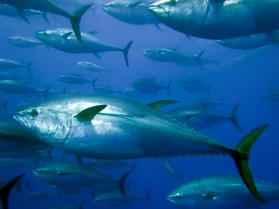Skretting brings tuna farming closer

Nutreco-owned fish feed company Skretting has developed a feed concept for bluefin tuna that brings ever closer the goal of breeding and rearing this much sought-after fish in captivity.
For many years, bluefin tuna, a carnivorous fish, has been in demand for its exclusive meat. However, increased demand has led to over-fishing and this fish is now considered to be a threatened species.
Since 1997, Skretting Australia has been involved in research on bluefin tuna and over the past year, Australian fish farmers have been able to conduct commercial farming of this lucrative fish using feed from Skretting.
Feed block concept
Karl Sveinsvoll, a researcher at Skretting ARC, said: ”The main challenge was to develop a feed with a texture and size that the bluefin tuna wanted to eat, at the same time as containing sufficient and the correct nutrients. This problem was solved by using the feed block concept, Aurora Gel, which was patented in 2003.”
ARC and Skretting are currently testing a new generation of feed blocks, which they have called AquaSoft Tuna.
Sveinsvoll said: “There are significant advantages of feeding formulated feed to bluefin tuna, as the alternative has usually been to feed them ‘trash fish’, such as herring and mackerel – with a feed conversion ratio up to 20.
“Formulated feed contributes toward greater sustainability, traceability, less risk of transmitting disease and better control of the nutritional profile of the fish.”
Global testing
Skretting is also testing the bluefin tuna feed in Japan, Spain and Turkey. So far, the results in Japan have been positive.
The trials in the Mediterranean countries have not been as successful until recently when the team experienced a breakthrough in Spain with the new feed.
Reproduction research fund
Although Skretting has a feed that the bluefin tuna likes, there are other pressing problems that must be solved before commercial farming of bluefin tuna is possible.
Bluefin tuna farming is currently based on wild fish that have been caught and fed until they reach harvesting weight.
Sveinsvoll said: “The challenge is to get the fish to reproduce in captivity and to get the fry to survive into adulthood.”
The challenge of “closing the life cycle” is the topic of SELFDOTT (Self-sustained Aquaculture and Domestication of Bluefin Tuna Thunnus thynnus), an EU-funded research project in which Skretting ARC, among others, is taking part.











